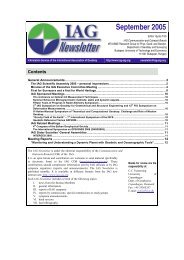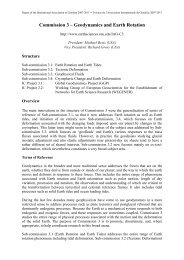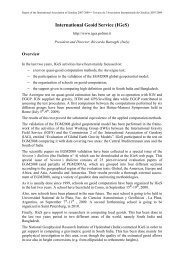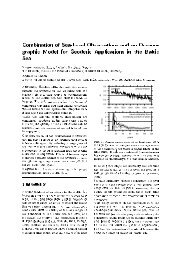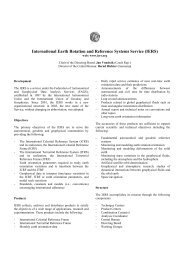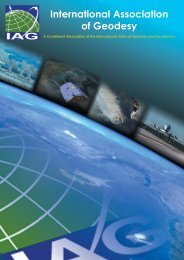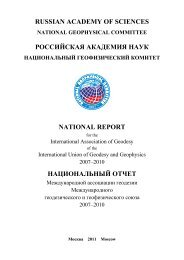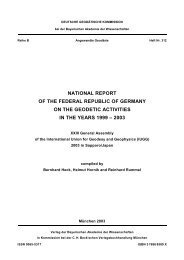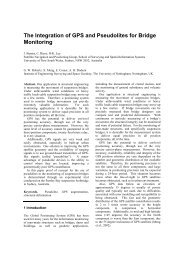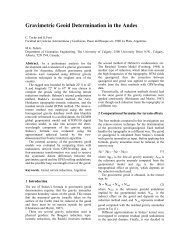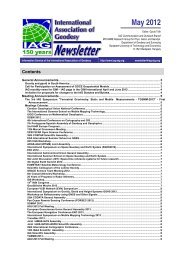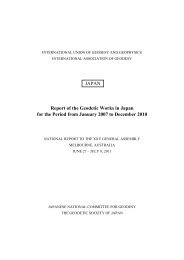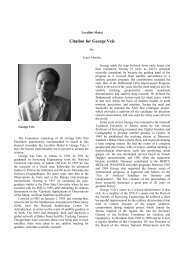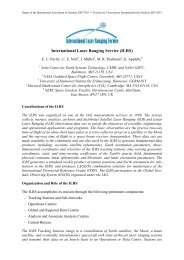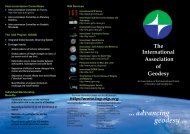Gravity Field - International Association of Geodesy
Gravity Field - International Association of Geodesy
Gravity Field - International Association of Geodesy
Create successful ePaper yourself
Turn your PDF publications into a flip-book with our unique Google optimized e-Paper software.
Photo: iStockPhoto (dra_schwartz, hidesy,<br />
Zhenikeyev)<br />
The <strong>Association</strong><br />
The <strong>International</strong> <strong>Association</strong> <strong>of</strong> <strong>Geodesy</strong><br />
(IAG) is the scientific organization responsible<br />
for the field <strong>of</strong> <strong>Geodesy</strong>. The origin <strong>of</strong> the IAG<br />
goes back to 1862, the year, in which the<br />
“Mitteleuropäische Gradmessung”, predecessor<br />
<strong>of</strong> the IAG was established. It<br />
promotes scientific cooperation and geodetic<br />
research on a global scale, and contributes to<br />
it through its various research bodies. It is an<br />
active member <strong>of</strong> the <strong>International</strong> Union <strong>of</strong><br />
<strong>Geodesy</strong> and Geophysics (IUGG), which itself<br />
is a member <strong>of</strong> the <strong>International</strong> Council for<br />
Science (ICSU).<br />
The scientific work <strong>of</strong> the <strong>Association</strong> is<br />
performed within a component structure<br />
consisting <strong>of</strong>:<br />
• Commissions<br />
• Inter-commission Committees<br />
• Services<br />
• The Global Geodetic Observing System<br />
(GGOS)<br />
• The Communication and Outreach<br />
Branch (COB), and<br />
• IAG Projects<br />
IAG mission<br />
The Mission <strong>of</strong> the <strong>Association</strong> is the advancement<br />
<strong>of</strong> <strong>Geodesy</strong>, an Earth science that<br />
includes the study <strong>of</strong> the planets and their satellites.<br />
The IAG implements its mission by:<br />
• advancing geodetic theory through research<br />
and teaching,<br />
• collecting, analysing and modelling observational<br />
data,<br />
• stimulating technological development,<br />
and<br />
• providing a consistent representation <strong>of</strong><br />
the figure, rotation and gravity field <strong>of</strong> the<br />
Earth and planets, and their temporal<br />
variations.<br />
IAG objectives<br />
• To foster geodetic research and development,<br />
• to support and maintain geodetic reference<br />
systems,<br />
• to provide observational and processed<br />
data, standards, methodologies and models,<br />
• to stimulate development <strong>of</strong> space techniques<br />
to increase the resolution <strong>of</strong> geodetic<br />
data,<br />
• to initiate, coordinate and promote international<br />
cooperations, and<br />
• to promote the development <strong>of</strong> geodetic activities<br />
across the globe, especially in developing<br />
countries.<br />
IAG meetings<br />
The IAG holds its own General Assembly<br />
every four years in conjunction with the<br />
General Assembly <strong>of</strong> the IUGG, at the same<br />
time and in the same country. In addition, the<br />
<strong>Association</strong> organizes Scientific Assemblies,<br />
independently from the IUGG, generally in the<br />
mid-term between the General Assemblies.<br />
Other meetings that the IAG sponsors or<br />
supports include numerous international<br />
symposia and workshops covering broad fields<br />
<strong>of</strong> <strong>Geodesy</strong> and closely associated sciences and<br />
engineering.<br />
7



